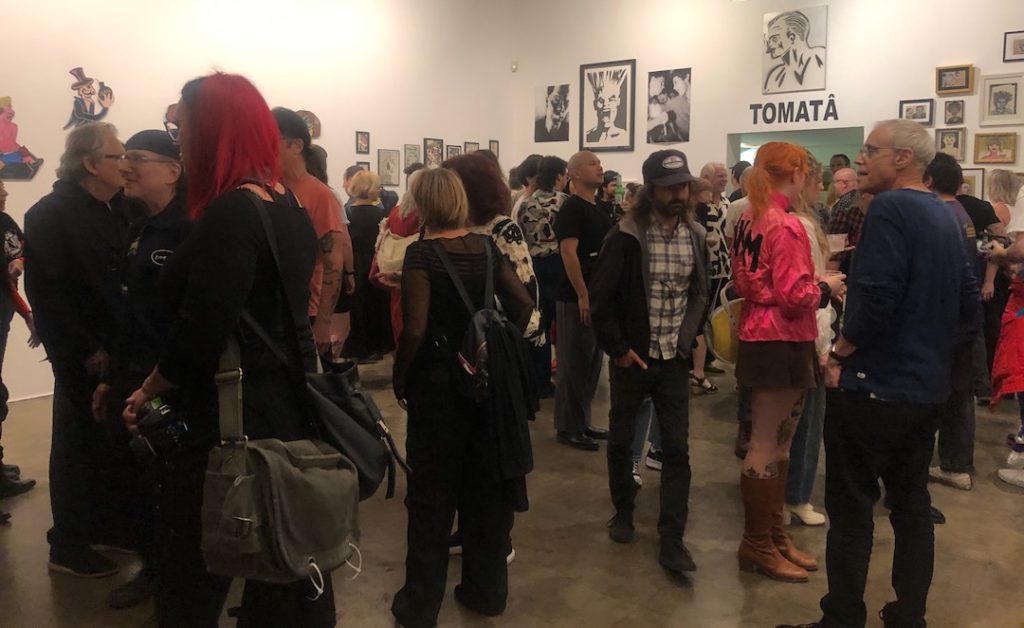
On Friday night, the party at MutMuz spilled out of the gallery and onto the otherwise quiet Chung King Road, a semi-hidden pedestrian street in Chinatown that’s known for art galleries. First wave L.A. punks mingled with my own generation of electro-weirdos, while a handful of teenagers milled about the gallery owned by Mark Mothersbaugh. On the walls was a retrospective of of the late artist Tomatâ du Plenty, including his paintings, as well as photos and ephemera related to his performances, including his time as the frontman of seminal synthpunk band the Screamers.
The Screamers are iconic for L.A. punk and I mean that in a very literal way. Gary Panter’s logo for the band, with spiked hair and face caught mid-scream, is one of, if not *the*, most recognizable piece of iconography from that era of L.A. music. You’re more likely to be familiar with The Screamers logo, and, probably, their story, than their music. Over the course of a handful of years, the band became a huge live draw locally, and even performed outside of Los Angeles, but didn’t actually release any music during their existence. The sole official piece of the band’s discography, a five song EP Screamers Demo Hollywood 1977, came out in 2021, more than 20 years after du Plenty’s death. If you weren’t around for 1970s punk, but somehow heard them, it was probably via a bootleg and probably after year heard about the Screamers via a zine or a blog or the people you encountered who were actually there.
The Screamers logo hangs in the gallery and photos from the shows are amongst those positioned right above the gallery’s doorway and front windows. The bulk of the collection, though, focuses on du Plenty’s visual art. Post-Screamers, du Plenty gravitated towards painting and carved out a career that would last the rest of his life. He was clearly a prolific artist, judging by the sheer volume of pieces in this one show, and there’s a punk attitude in much of the work, which is heavy on portraits and includes paintings on wood and on book pages.

The portraits vary from literary figures, like Proust and Rimbaud, to subculture heroes like Johnny Thunders and pop culture icons like Dolly Parton. He touches on politics in a Silence = Death piece and shows his sense of humor in a bawdy depiction of the Brontë sisters. A short story that’s included in the show, “The House of Burning Desire,” and its accompanying illustration, gives a glimpse into a dark childhood in Montebello. TOMATÂ does a good job of lending insight into a multi-faceted, creative person by presenting his work from various different periods of his life. In doing that, they shift the focus from art as a thing to art as a human act, which is so important right now.
I find the legend of the Screamers more interesting now than ever. In the 1990s, when I first heard the band referenced, it was unusual that a band was said to be such a big live draw without releasing any recordings. Yet, it also didn’t seem totally out of the ordinary. We were still a few years away from accessible home studio gear and Web 2.0, so, unless bands had the backing of a label, they had to rely on the strength of their live shows and literal word-of-mouth promotion. That the Screamers were selling out local venues without so much as a single said more about record labels than the band.
Today, the inverse is true to an extreme. AI can generate the music, the images and the backstory for a band that doesn’t actually exist. And since likes, streams and every other metric by which people judge the value of art content today can be faked, the band that doesn’t really exist can garner a significant base of fans who also don’t actually exist. Even if platforms had to post disclaimers for AI content, it wouldn’t make much of a difference because there simply aren’t enough people who care. This isn’t just a matter of living in the age of bots, it’s also that flesh-and-blood humans act more and more like bots every day. Scroll, like, share, repeat. Don’t think to much about it, just feed the beast. All of this is terrible for culture in that it strips art of its humanity. And, I think, if you see TOMATÂ, which is on view at MutMuz until mid-September, you’ll at least start to understand why that’s such a big deal.
Liz O. is an L.A.-based writer and DJ. Read her recently published work and check out her upcoming gigs or listen to the latest Beatique Mix. Follow on Instagram or Bluesky for more updates.
Keep Reading:
Brenton Wood, Thee Midniters and More Featured in Museum Exhibition “A Great Day in East L.A.”
N8NOFACE and Chico Mann Update a Classic Alternative Sound on As of Right Now
Flashback to 1980s L.A. with Grey Factor on Live Album, A Peak in the Signal